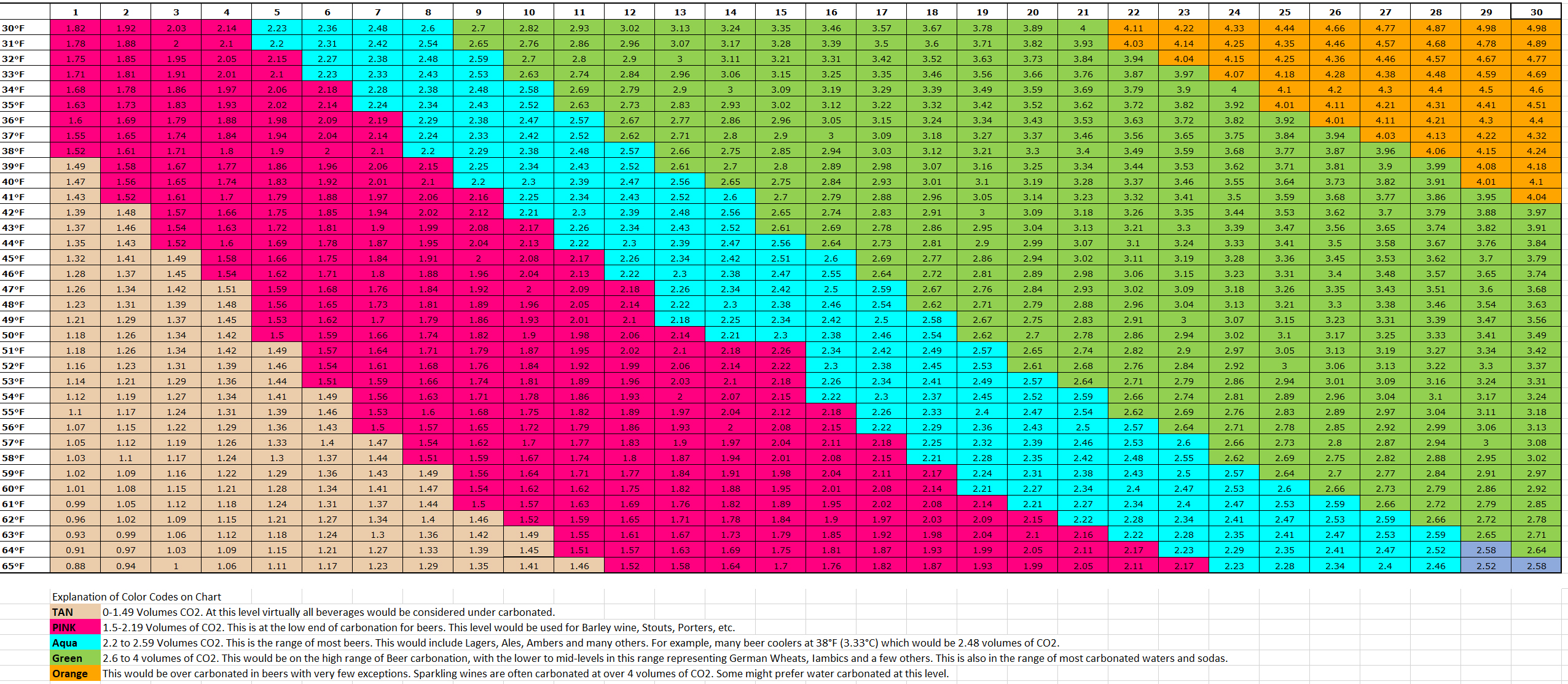English 

No.21-2 of Jiyang Industrial Park, Jiyang District, Jinan, Shandong, China

No.21-2 of Jiyang Industrial Park, Jiyang District, Jinan, Shandong, China
How many CO2 content should be the standard percentage in beer? Or any of the other carbonted beverage?

Why Carbonation?
Carbonation is measured as either ‘volumes’ or grams per litre.
One volume means 1 L of CO2 in 1 L of drink. This is equivalent to 1.96 g/L (normally quoted as 2 g/L).
A typical carbonated soft drink contains approximately 3–4 volumes (6–8 g/L) CO2.
Carbonation is usually determined in soft drinks by measuring the pressure in the container at a known temperature. The pressure inside a container (can or bottle) is dependent upon the level of dissolved CO2 and the temperature. Water at 0oC will dissolve approximately 3.6 g/L CO2. At higher concentrations or higher temperatures elevated pressure is required to retain the CO2 in solution.
Carbonation may be one of the most overlooked and underrated component of beer. Water, barley, hops, and yeast take center stage, and it is often said that these are only four items needed to make beer. It is easy to believe that these four ingredients alone determine the outcome of the final product, but carbonation plays an extremely important role in the drinker’s experience. Carbonation affects all aspects of a beer including flavor, aroma, appearance, and mouth feel. Some may argue that carbonation is not a true “ingredient” in the same sense as the “big four”. In the case of naturally carbonated beers, this can be understood given that the carbonation is a by-product of the yeast’s “secondary fermentation” in the bottle, much like alcohol itself is a by-product of yeast activity rather than an actual ingredient added by the brewer. However, this is less true in the case of beers force-carbonated from an external CO2 source.
2. How many CO2 should I consider to add into my beer?
A finished beer just out of the fermenter may have 1.1-1.7 volumes of residual CO2 just as a product of the fermentation process.
To increase that level to the desired volume of c02, you can refer to the carbonation chart.
The chart has an X,Y format so that you can see the temperature on the left and the number of psi on the regulator at the top of the chart. Where those intersect is the resulting volume of CO2.
For example, my kegerator is at 40 degrees and I have an IPA that I would like to have at 2.47 volumes of CO2. That means I would set my pressure on my regulator to 12 psi. The aqua area of the chart is generally where most of the beers would range, with noted exceptions at the bottom of the chart.
Sparkling water on tap is becoming very popular. Depending on your preference, the water can be at a slightly sparkling level or much more highly carbed to a soda level. Normally, the slightly effervescent setting would be around 3 volumes of CO2, while a very highly carbed setting would be more like 4-5 volumes of CO2. The same is true with cider or kombucha with similar volumes of CO2.
Soda tends to be more highly carbonated, as much as 4 volumes of c02 is usual. Since these other beverages like seltzer and cider would be according to personal preference, you may want to experiment with the perfect amount of carbonation for your palate.

As brewers, we all enjoy making beer and then tasting the fruits of our labors. When you pour a glass of beer, one of the first things you’ll notice is the level of carbonation. Because of the fermentation process itself, where sugars are converted into carbon dioxide (CO2) and ethanol, beer naturally has a level of carbonation when it comes out of the fermenter. The brewer will often then add additional fermentable sugars to the beer when packaging, or force carbonate with CO2 so that there is more carbonation in the final product.
Carbonation is a large part of the beer drinker’s experience. While carbonation itself isn’t exactly a flavor, it definitely influences the perception of the aroma and flavor, as well as the mouthfeel. An undercarbonated beer will seem a bit lifeless, dull and without much aroma. The bubbles in the beer should rise from the bottom of the glass to the top forming the head and also bring the aroma of malt and hops to the drinker’s nose. The fine bubbles are a large part of the mouthfeel and impact the flavors on the palate as well. From a relatively uncarbonated real ale in a cask to a near champagne-like carbonation of a brut IPA or German weizen, the level of carbonation impacts the drinker’s total experience with that beer.
The style being made generally dictates how much carbonation should be in a particular beer. A cask conditioned real ale has a low level of carbonation as it is often gravity fed or pumped by a beer engine into a glass. Although this is not as common today in the US, at one time it was the primary way to serve beer, particularly in the UK. This lower carbonation can enhance the complexity of the beer, bringing more notice to the roastiness of a stout or the gentle hopping of a mild ale. These ales are usually served a bit warmer than lagers as well so that the flavors are more prominent to the drinker. As a contrast, a German weizen will be exceedingly bubbly with a higher carbonation level and served colder. This higher level will allow the head to “float” on top of the beer, creating the distinctive white foam, as well as provide a bit of a carbonic acid bite to the flavor due to this higher carb level. In between these two style examples, other styles tend to be
If you have any customization needs, feel free to contact us.
Contact Details:
- Email: info@carrybrew.com
- Number: +86 15662675200
- Website: www.carrybrew.com